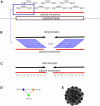Genome-wide characterization of centromeric satellites from multiple mammalian genomes
- PMID: 21081712
- PMCID: PMC3012921
- DOI: 10.1101/gr.111278.110
Genome-wide characterization of centromeric satellites from multiple mammalian genomes
Abstract
Despite its importance in cell biology and evolution, the centromere has remained the final frontier in genome assembly and annotation due to its complex repeat structure. However, isolation and characterization of the centromeric repeats from newly sequenced species are necessary for a complete understanding of genome evolution and function. In recent years, various genomes have been sequenced, but the characterization of the corresponding centromeric DNA has lagged behind. Here, we present a computational method (RepeatNet) to systematically identify higher-order repeat structures from unassembled whole-genome shotgun sequence and test whether these sequence elements correspond to functional centromeric sequences. We analyzed genome datasets from six species of mammals representing the diversity of the mammalian lineage, namely, horse, dog, elephant, armadillo, opossum, and platypus. We define candidate monomer satellite repeats and demonstrate centromeric localization for five of the six genomes. Our analysis revealed the greatest diversity of centromeric sequences in horse and dog in contrast to elephant and armadillo, which showed high-centromeric sequence homogeneity. We could not isolate centromeric sequences within the platypus genome, suggesting that centromeres in platypus are not enriched in satellite DNA. Our method can be applied to the characterization of thousands of other vertebrate genomes anticipated for sequencing in the near future, providing an important tool for annotation of centromeres.
Figures



References
-
- Alexandrov IA, Mitkevich SP, Yurov YB 1988. The phylogeny of human chromosome specific alpha satellites. Chromosoma 96: 443–453 - PubMed
-
- Alexandrov I, Kazakov A, Tumeneva I, Shepelev V, Yurov Y 2001. Alpha-satellite DNA of primates: Old and new families. Chromosoma 110: 253–266 - PubMed
-
- Alves G, Seuanez HN, Fanning T 1994. Alpha satellite DNA in neotropical primates (Platyrrhini). Chromosoma 103: 262–267 - PubMed
Publication types
MeSH terms
Substances
Grants and funding
LinkOut - more resources
Full Text Sources
